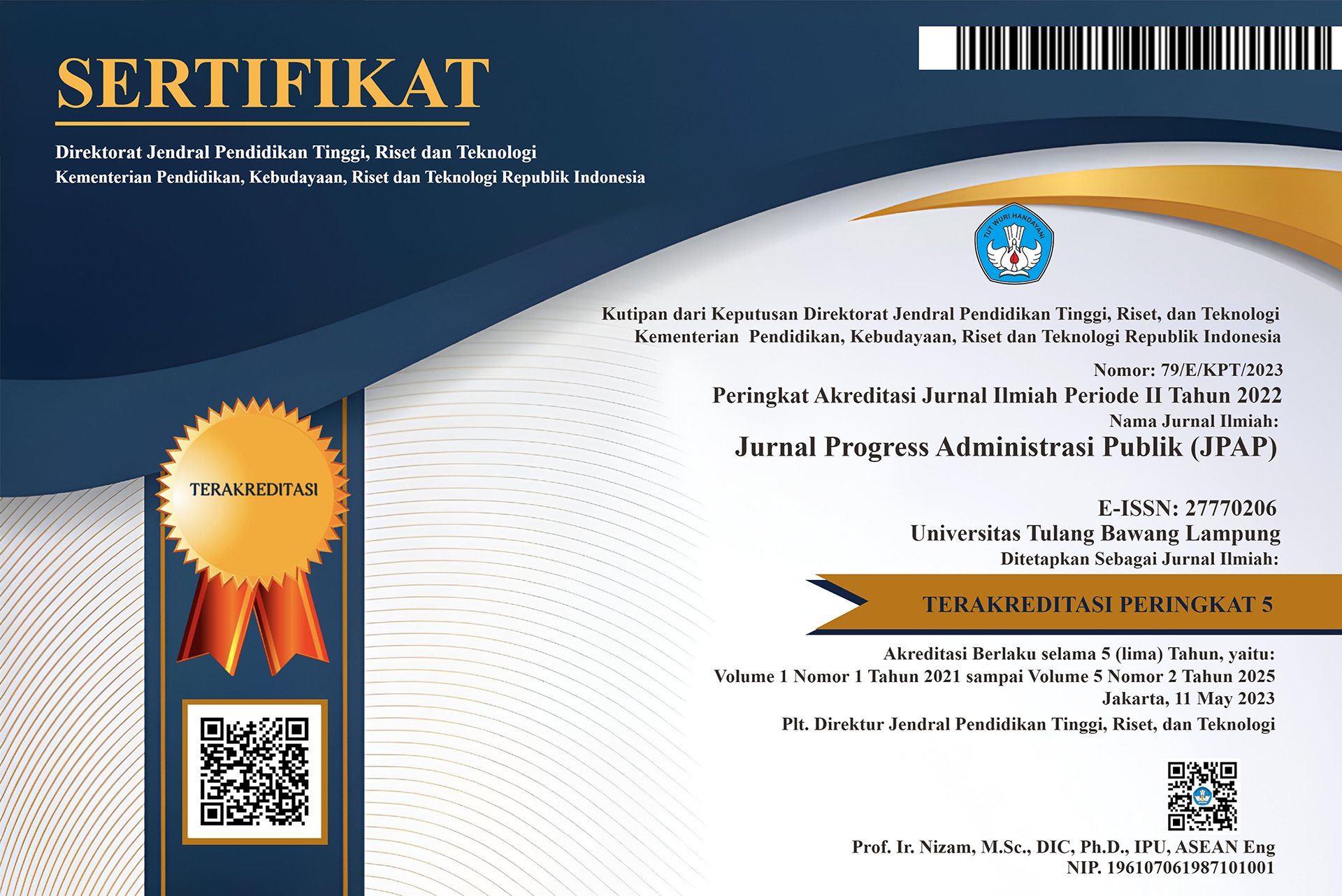IMPLEMENTASI PERATURAN DISPENSASI NIKAH BERDASARKAN UNDANG-UNDANG NO 16 TAHUN 2019 TENTANG PERNIKAHAN DI KECAMATAN KEMUNING KOTA PALEMBANG
DOI:
https://doi.org/10.37090/jpap.v3i2.1164Abstract
The research aims to find out how the implementation of marriage regulations, Marriage Law no. 16 of 2019 in Kemuning District, Palembang City. The research method used is a descriptive method with a qualitative approach. Data collection techniques used include observation, interview and documentation methods, as well as sampling techniques, namely, with individuals and groups who may have information about the subject being studied. Qualitative descriptive method was used as a research method. As data collection methods, observation, survey and documentation methods were used, as well as sampling methods, namely, people who knew the subject of investigation in Kemuning District, Palembang City. Furthermore, the results of the analysis and field results of this research use Van Metter and Van Horn's theory which includes 6 indicators, namely size and policy, resources, implementation characteristics, implementation attitude, communication between organizations, economic, social and political environment. This indicates that the government itself has not implemented it effectively. good and optimal Decree Law No. 16 of 2019 concerning Marriage in Kemuning District, Palembang City. The unfavorable social, economic and political environment causes the implementation of Law No. 16 concerning Marriage to not run smoothly and optimally. Based on the research conducted, it was found that the implementation of the marriage dispensation by the Office of Religious Affairs (KUA) in Kemuning District, Palembang City has not run well and optimally because the local government has not been optimal and the social, economic and political environment has not run well and optimally.
Keywords: Implementation; Marriage; Dispensation
Downloads
References
Marc, E., & Picard, D. (2006). L’école de Palo Alto. L’école de Palo Alto, 1–17.
Tachjan. (2006). Implementasi Kebijakan Publik. Bandung: AIPI, hal 38-40.
Gios Adhyaksa, A. F. W. N. (2021). Implementasi Dispensasi Perkawinan Di Bawah Umur. 6(1). https://dx.doi.org/10.24235/mahkamah.v6i1.7815.g3647
Salsabilah, N., & Sulistiyantoro, H. (2021). Dispensasi Kawin Di Bawah Umur Menurut Undang-Undang Nomor 16 Tahun 2019 Tentang Perubahan Atas Undang-Undang Nomor 1 Tahun 1974 Tentang Perkawinan Di Pengadilan Agama Surabaya. Jurnal Health Sains, 2(6), 1103–1119. https://doi.org/10.46799/jsa.v2i6.248
Sugiyono, D. (2013). Metode penelitian pendidikan pendekatan kuantitatif, kualitatif dan R&D.
Ton, W. L., Zakariya, & Teguh, S. (2019). Implementasi Batas Minimal Usia Perkawinan Berdasarkan UU No 16 Tahun 2019 Tentang Perkawinan Di Kecamatan Pasangkayu. 16, 1–10.
V.A.R.Barao, R.C.Coata, J.A.Shibli, M.Bertolini, & J.G.S.Souza. (2022). No 主観的健康感を中心とした在宅高齢者における 健康関連指標に関する共分散構造分析Title. Braz Dent J., 33(1), 1–12.
WINARNI, W. E. (2018). ANALISIS GAYA BELAJAR SISWA LAMBAN BELAJAR (SLOW LEARNER) DI KELAS III SDN 2
WANADADI (Doctoral dissertation, UNIVERSITAS MUHAMMADIYAH PURWOKERTO)
Afif. (Juli 2, 2020). MENAKAR POTENSI DISPENSASI NIKAH PASCA REVISI UU PERKAWINAN. Hamidi. (Desember 12, 2019). DISPENSASI KAWIN MENURUT PERMA NO 5 TAHUN 2019. https://pa-palangkaraya.go.id/dispensasi-kawin-menurut-perma-nomor-5-tahun-2019/.
Hamidi. (Desember 12, 2019). DISPENSASI KAWIN MENURUT PERMA NO 5 TAHUN 2019. Hamidi. (Desember 12, 2019). DISPENSASI KAWIN MENURUT PERMA NO 5 TAHUN 2019. https://pa-palangkaraya.go.id/dispensasi-kawin-menurut-perma-nomor-5-tahun-2019/.
Downloads
Published
Issue
Section
License
Copyright (c) 2023 Jurnal Progress Administrasi Publik (JPAP)

This work is licensed under a Creative Commons Attribution-ShareAlike 4.0 International License.























